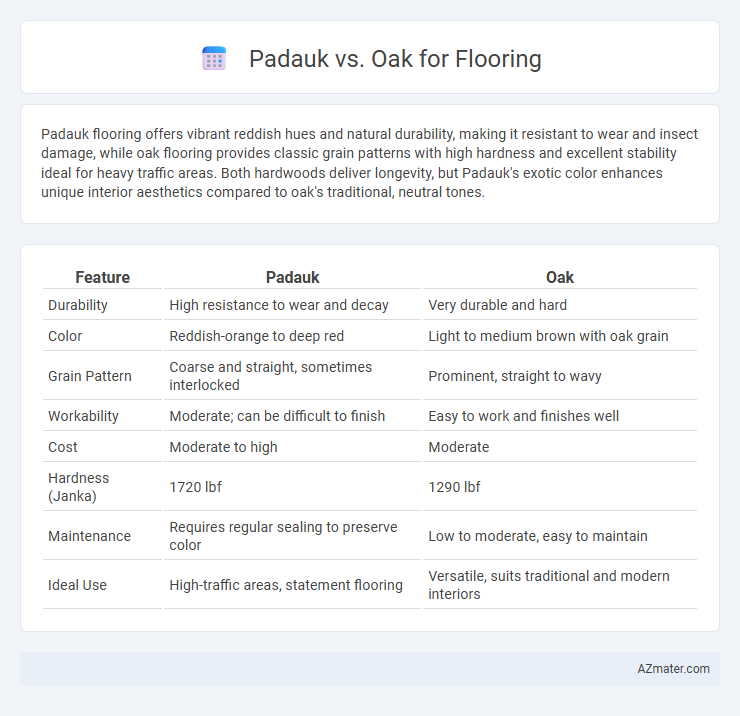Padauk flooring offers vibrant reddish hues and natural durability, making it resistant to wear and insect damage, while oak flooring provides classic grain patterns with high hardness and excellent stability ideal for heavy traffic areas. Both hardwoods deliver longevity, but Padauk's exotic color enhances unique interior aesthetics compared to oak's traditional, neutral tones.
Table of Comparison
| Feature | Padauk | Oak |
|---|---|---|
| Durability | High resistance to wear and decay | Very durable and hard |
| Color | Reddish-orange to deep red | Light to medium brown with oak grain |
| Grain Pattern | Coarse and straight, sometimes interlocked | Prominent, straight to wavy |
| Workability | Moderate; can be difficult to finish | Easy to work and finishes well |
| Cost | Moderate to high | Moderate |
| Hardness (Janka) | 1720 lbf | 1290 lbf |
| Maintenance | Requires regular sealing to preserve color | Low to moderate, easy to maintain |
| Ideal Use | High-traffic areas, statement flooring | Versatile, suits traditional and modern interiors |
Introduction to Padauk and Oak Flooring
Padauk flooring is prized for its rich reddish-orange hues and durability, making it a standout choice for vibrant, long-lasting hardwood floors. Oak flooring, available in red and white varieties, offers exceptional strength and a timeless, versatile grain pattern that complements diverse interior styles. Both woods provide sturdy, wear-resistant surfaces ideal for high-traffic areas, with Padauk delivering bold color contrast and Oak maintaining classic neutral tones.
Appearance and Color Differences
Padauk flooring features a striking reddish-orange hue that deepens to a rich reddish-brown over time, creating a warm and exotic aesthetic ideal for bold interior designs. Oak flooring offers a more traditional appearance with lighter tones ranging from creamy beige to medium brown, showcasing prominent grain patterns that provide a classic, versatile look. The contrasting color saturation and grain texture between Padauk and Oak make Padauk a statement choice for vibrant spaces, while Oak suits timeless, neutral decor themes.
Grain Pattern and Texture Comparison
Padauk flooring features a bold, interlocking grain pattern with a coarse, uneven texture that adds a vibrant, exotic character to interiors. Oak flooring offers a more pronounced, straight grain pattern with a smoother, uniform texture, providing a classic and timeless aesthetic. The distinct grain and texture differences between Padauk's dynamic visual appeal and Oak's subtle sophistication influence the design choice for various architectural styles.
Durability and Hardness Ratings
Padauk flooring boasts a Janka hardness rating of approximately 1,970, making it significantly harder and more resistant to dents than most Oak species, which typically range from 1,290 (Red Oak) to 1,360 (White Oak). Both woods are durable, but Padauk's higher density grants superior wear resistance and longevity in high-traffic areas. Oak flooring, while slightly softer, offers greater stability and easier refinishing, appealing to homeowners seeking a balance between durability and maintenance.
Resistance to Moisture and Wear
Padauk offers superior resistance to moisture compared to oak, making it an excellent choice for areas prone to humidity and occasional spills. Its dense grain structure enhances durability and wear resistance, maintaining its vibrant color and finish over time. Oak, while durable with a robust hardness rating, tends to absorb moisture more readily, increasing the risk of warping and surface damage in wet conditions.
Maintenance and Cleaning Requirements
Padauk flooring demands more frequent maintenance due to its vibrant reddish hue, which can fade if exposed to direct sunlight and harsh cleaning chemicals. Oak flooring offers durability with less intensive upkeep, requiring regular sweeping and occasional mopping using pH-neutral cleaners to maintain its natural finish. Both woods benefit from periodic resealing to protect against scratches and moisture damage, but Padauk's dense grain makes it slightly more resistant to dents and stains compared to Oak.
Installation Process and Methods
Padauk flooring requires careful acclimation due to its high natural oil content and tendency to expand, necessitating longer adjustment periods before installation compared to oak. The installation method for Padauk typically involves nail-down or glue-down techniques to ensure stability, while oak flooring offers more versatility with click-lock, nail-down, glue-down, or staple-down options. Proper subfloor preparation is critical for both woods, but Oak's dimensional stability often results in a more straightforward installation process, reducing potential issues like cupping or warping post-installation.
Cost Comparison: Padauk vs Oak
Padauk flooring typically costs between $8 and $12 per square foot, reflecting its exotic hardwood status and unique reddish-brown hue, while oak flooring ranges from $3 to $10 per square foot, offering a more budget-friendly option with wide availability. The higher price of Padauk is influenced by limited supply and import expenses, contrasting with oak's domestic abundance and variety, which allows for competitive pricing. Investing in Padauk provides a distinctive, durable surface with a premium price, whereas oak offers versatile aesthetics and cost efficiency suitable for larger projects.
Sustainability and Environmental Impact
Padauk flooring offers strong sustainability credentials due to its fast growth rate and availability from managed plantations, reducing deforestation pressures commonly associated with hardwood harvesting. Oak, while durable and popular, typically comes from slower-growing species, which can contribute to habitat loss and higher environmental impact unless sourced from certified sustainable forests. Choosing padauk can lower carbon footprint and promote eco-friendly practices, whereas oak requires careful sourcing to ensure minimal ecological damage.
Best Uses and Style Recommendations
Padauk flooring showcases a rich reddish-orange hue and high durability, making it ideal for high-traffic areas such as living rooms and hallways where a bold, exotic look is desired. Oak flooring, available in red and white varieties, offers a classic, versatile style suited for traditional and modern interiors, performing well in kitchens and bedrooms due to its moderate hardness and resistance to wear. Both woods provide excellent stability, but Padauk's vibrant color demands regular maintenance to prevent fading, whereas oak's neutral tones complement a wide range of decor styles and finishes.

Infographic: Padauk vs Oak for Flooring
 azmater.com
azmater.com